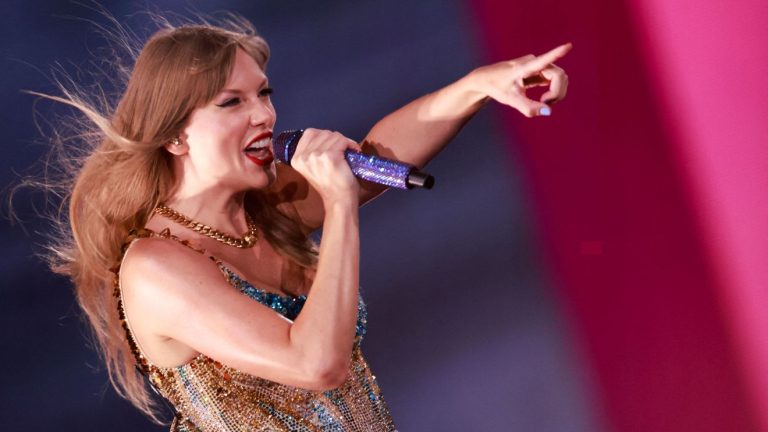When Dallas resident Adriana Akhtar planned a recent Los Angeles trip with her family to see Taylor Swift perform as part of the artist’s ballyhooed “Eras Tour,” she wasn’t necessarily thinking about boosting the local economy.
But over the course of four days, Akhtar, 47, did just that: She estimates her family spent about $35,000 on luxury accommodations, meals at some of the city’s hottest restaurants and transportation within the area — and that figure doesn’t even include a five-figure shopping splurge. In short, her Taylor trip became an L.A. vacation done to the max.
And Akhtar makes the point that she was hardly alone. “Rodeo Drive was overrun with moms and daughters in town for Taylor Swift,” she told MarketWatch.
Add up all that spending by so many Swifties over the course of Swift’s sold-out, six-show run at SoFi Stadium in the Los Angeles suburb of Inglewood and you have a $320 million boost to the city, according to a detailed report from the California Center for Jobs & the Economy. The Los Angeles engagement concluded Wednesday night, which also marked the end of the first leg of the “Eras Tour.”
Notably, the $320 million doesn’t include the bulk of the money spent on tickets and merchandise, since that’s channeled to Swift, officials with the center told MarketWatch. But if that was added to the mix, the total would be $490 million — or nearly a half-billion dollars. The $320 million does, however, encompass everything from hotel stays and restaurant visits to sales taxes generated.
It’s been estimated that 420,000 people attended the Swift shows in Los Angeles. Many of those traveled from out of town — just like Akhtar. And befitting the joyous mood of the concerts, they clearly came to have a good time and spend, spend, spend, said Robert Lapsley, president of the California Business Roundtable, which runs the center.
“This became a vacation for people,” Lapsley told MarketWatch. “They probably planned their whole summer around it.”
The phenomenon was hardly limited to Los Angeles. Cities across the U.S. that hosted the tour saw all kinds of upticks in business.
In Philadelphia, hotel bookings surged during the month of May, which was when the tour was in town for three nights. The boost even drew the attention of the Federal Reserve Bank of Philadelphia, which said it “was the strongest month for hotel revenue in Philadelphia since the onset of the pandemic, in large part due to an influx of guests for the Taylor Swift concerts in the city.”
Denver enjoyed a lesson in “Swiftonomics” as well. The two shows that Swift played there resulted in a $140 million gain for the city, according to the Common Sense Institute, a group that tracks the Colorado economy.
But you don’t need to convince Shelley Yates-Laguna of that. As the general manager of Death & Co., the bar and restaurant operator at the Ramble Hotel in Denver, Yates-Laguna saw the crowds forming at her establishment during tour time. The wait for a table exceeded more than two hours at one point, she said.
“Some people we weren’t able to get to at all,” she noted of the unprecedented demand.
In all, the “Eras Tour” will provide a $5 billion boost to the global economy, according to market researcher QuestionPro — “more than the gross domestic product of 50 countries,” the company said in a press release. QuestionPro said that each concertgoer spends about $1,300 on average to attend the show, including the cost of the ticket itself.
““This became a vacation for people. They probably planned their whole summer around it.””
Dan Fleetwood, QuestionPro’s president of research and insights, told MarketWatch that he believes people are opening their wallets for Swift shows in part because they haven’t had a chance to celebrate like this since the onset of the pandemic.
“It’s almost like we’re seeing some revenge spending from being pent-up during COVID,” he said.
If that’s the case, Swift’s Los Angeles shows may have equated to revenge spending on steroids. Several factors contributed to why the six-concert engagement had that supersized $320 million impact, said officials with the California Center for Jobs & the Economy and others who have tracked the Swift economic boom.
For starters, it was the longest run of shows that Swift has done in any city so far. Plus, it was in a region that offers no shortage of attractions, so those who traveled from out of town for a concert had plenty of opportunities to extend their trip, from visiting theme parks (think Disneyland) to, yes, shopping on Rodeo Drive.
If anything, there’s hope that the impact will continue beyond the concerts. Chris Heywood, a senior vice president of the Los Angeles Tourism and Convention Board, said the goal is to convince Swifties who had a good time while in town to return to the city — even if there isn’t a concert beckoning them.
In effect, the Swift engagement was a tourism “advertising campaign that money can’t buy,” Heywood said. He added that the tour couldn’t have come at a better time, since Los Angeles is gearing up to host the summer Olympics in 2028 — with the opening and closing ceremonies slated to be held at the same stadium where Swift performed.
For Adriana Akhtar, the Taylor trip-to-end-all-Taylor trips might be spurring a different future travel plan: She’s already thinking ahead to some of the cities where Swift is playing when her tour resumes.
On the top of her list: Paris and London. “We could do a family vacation and see her, too,” she said.
Read the full article here









